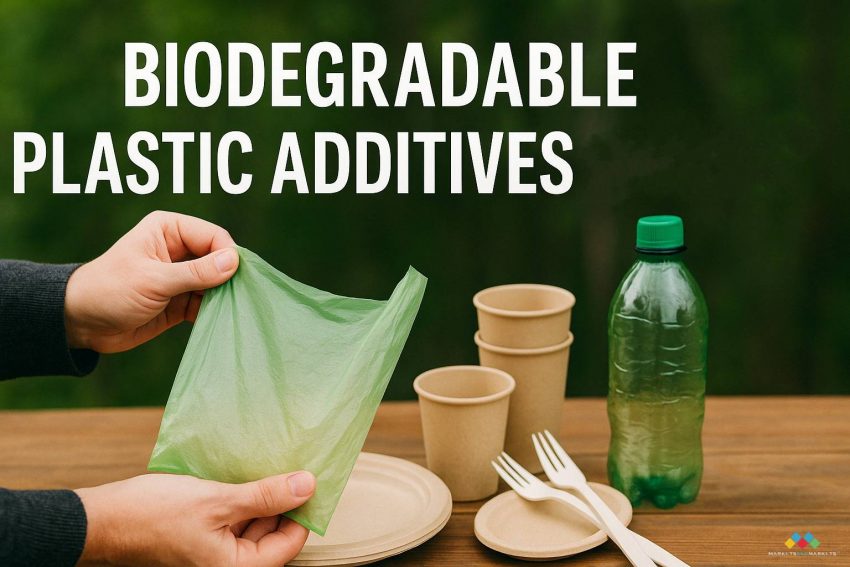The global war on plastic waste has sparked a major shift in how we think about packaging, consumer goods, and materials at large. With rising environmental concerns and stricter regulatory mandates, industries are pivoting to solutions that leave a lighter footprint. That’s where the Biodegradable Plastic Additives Industry steps in—offering a realistic and scalable route toward sustainability.
These additives are quietly changing the way we use plastics. They’re not a complete replacement, but they bridge the gap between performance and eco-responsibility, helping conventional plastics degrade faster and more efficiently under appropriate conditions. Let’s break down what’s driving this industry, where it’s headed, and why it matters for businesses and the planet.
What Are Biodegradable Plastic Additives?
Biodegradable plastic additives are compounds blended with traditional polymers like polyethylene (PE), polypropylene (PP), or polystyrene (PS) to accelerate the degradation process. They allow plastics to break down more quickly when exposed to natural elements like heat, oxygen, moisture, or microorganisms—transforming long-lasting waste into carbon dioxide, water, and biomass.
These additives don’t compromise product performance. They retain the strength, clarity, and flexibility required in everything from food packaging to agricultural films—making them a valuable upgrade in sectors that depend on plastics but are under pressure to go green.
Market Drivers: Why Demand Is Surging
The global biodegradable plastic additives market was valued at USD 1.49 billion in 2024 and is projected to reach USD 2.20 billion by 2029, growing at 8.1% cagr from 2024 to 2029.
1. Environmental Regulations Are Getting Tougher
Governments worldwide are cracking down on single-use plastics. Europe’s Single-Use Plastics Directive, India’s ban on plastic carry bags, and various state-level mandates in the U.S. are driving companies to seek alternatives. Biodegradable additives help businesses stay compliant without a complete overhaul of materials.
2. Consumer Pressure for Sustainable Packaging
From coffee cups to e-commerce packaging, customers today are scrutinizing what their products are made of. Brands that offer biodegradable or eco-friendly alternatives have a competitive edge—especially in retail, food & beverage, and personal care industries.
3. Corporate Sustainability Goals
Companies are under pressure from investors, shareholders, and watchdogs to demonstrate climate-conscious operations. Incorporating biodegradable additives into plastic production is a low-barrier strategy to move closer to sustainability targets.
4. Innovation in Additive Technology
Early additives had limitations, but the new generation is smarter and more effective. Manufacturers now offer additives that work in various environments—landfills, industrial composting units, and even marine conditions—broadening the range of viable applications.
Key Application Areas
– Packaging Industry
Single-use plastic packaging continues to be a major contributor to plastic waste. Biodegradable additives help mitigate the impact of food wrappers, shopping bags, and shrink films without sacrificing durability or appearance.
– Agriculture
In agriculture, mulch films, greenhouse covers, and irrigation components often use plastic. Biodegradable additives enable these materials to break down after their lifecycle, reducing plastic buildup in soil.
– Consumer Goods
Cutlery, plates, containers, and straws are increasingly incorporating biodegradable plastic additives to reduce their long-term environmental impact.
– Textile and Medical
Nonwoven fabrics, medical packaging, and hygiene products are beginning to use biodegradable solutions to minimize post-use waste.
Challenges Facing the Industry
While the biodegradable plastic additives market is booming, it’s not without hurdles:
- Lack of Universal Standards: There’s still confusion around what qualifies as biodegradable. Regulatory inconsistencies make it tough for companies to scale globally.
- End-of-Life Infrastructure: Most biodegradable additives require specific environments (like industrial composters) to fully break down. Without the right disposal systems, they may not reach full effectiveness.
- Cost Factors: Biodegradable additives can be more expensive than traditional plastic solutions, which may deter smaller companies or price-sensitive industries.
Key Players and Innovation
Companies like BioSphere Plastic, Willow Ridge Plastics, TDPA by EPI, and Mango Materials are leading the charge. Many are developing additives that work with a wide range of polymers and are designed for custom degradation timelines, ensuring maximum flexibility for clients.
Regional Insights
- North America is seeing strong demand, especially in food service, packaging, and agriculture. State-driven policies and green consumers are pushing adoption.
- Europe continues to lead in legislation, with high demand across industries thanks to robust environmental directives.
- Asia-Pacific is the fastest-growing market, with China and India emerging as manufacturing hubs and simultaneously facing intense scrutiny over plastic waste.
Stay ahead with the latest trends – Download the PDF brochure.
Conclusion :
The Biodegradable Plastic Additives Industry isn’t the silver bullet to solve plastic pollution—but it’s a practical and impactful step forward. These additives give existing materials a second chance—one that aligns better with circular economy goals, consumer values, and regulatory frameworks. For companies in packaging, agriculture, food service, or manufacturing, integrating biodegradable plastic additives is no longer a novelty—it’s becoming a necessity.

